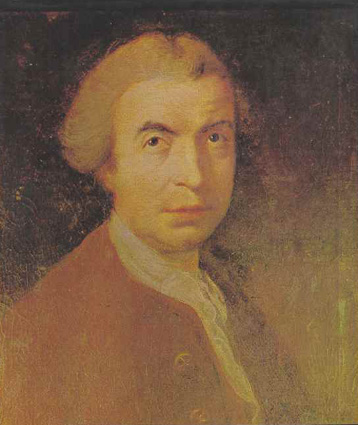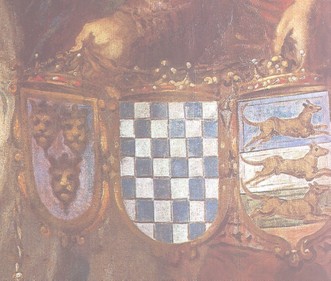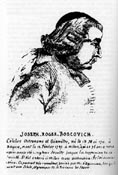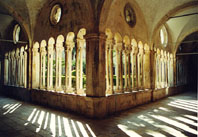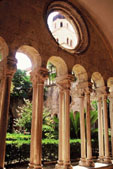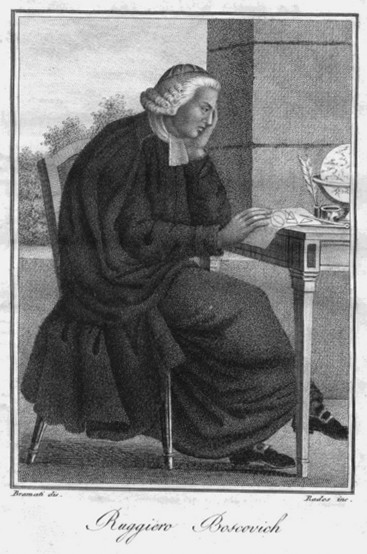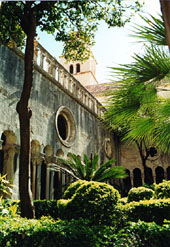 | Rudjer Boskovic (1711-1787), born in Dubrovnik 300 years ago, was a member of the Royal Society of London, a member of St.Petersbug Academy, "membre correspondant" of the French Academie Royale des Sciences. According to Werner Heisenberg, "Boskovic occupies outstanding place as a theologian, philosopher, mathematician, and astronomer." On the left portrait of Boskovic by Edge Pine, London 1760. |
| The greatest and most famous Croatian philosopher and scientist Rudjer Boskovic (Boscovich, 1711-1787), was born in Dubrovnik, where he was educated in the Jesuit Collegium. He was a member of the Royal Society of London, a member of St.Petersbug Academy, "membre correspondant" of the French Academie Royale des Sciences, a member of the Accademia dell'Arcadia, a professor at many European universities. Very delicate work on repairing the cupola of St. Peter's church in the Vatican (diameter: 42m) was entrusted to R. Boskovic, a proof that he was a leading European authority for static computations and civil engineering of that time. Upon the request of Austrian Empress Maria Theresia, Boskovic was solving the problem of stability of Royal Library (now National Library) in Vienna. Portrait of Boskovic by the English painter Edge Pine (London, 1760). He was also the founder of the astronomical observatory in Brera near Milan. In 1773 a charter granted by Louis XV made him a French subject. Soon he was appointed by Louis XV to a very prestigious position and became the Director of Naval Optics of the French Navy in Paris (Optique Militaire de la Marine Royale de France). He left to his adoptive country an achromatic telescope and micrometer. Boskovic spent nine years in France, and became a good friend to many outstanding scientist, like the mathematician Clairaut, Lalande, Buffon. When D'Alembert took him for Italian, he hastened to correct him. Boskovic stayed 7 months in England and met many famous scientists there: James Bradley (famous astronomer), George Parker (president of the Royal Academy), Samuel Johnson (Lexicographer), Edmund Burke (philosopher and political writer), Joshua Reynolds (the first president of the Royal Academy of Arts), and others. It is interesting that in England he designed a telescope filled with water in all its components, which was implemented at the Greenwich observatory in 1871, that is, 84 years after his death. He also met Benjmanin Franklin, who showed him some of his electrical experiments, see an article by Branko Franolic.
A detail from the Jesuit Collegium where R. Boskovic was educated, Boskovic was also a brilliant Croatian Latinist poet. He wrote an extensive scientific epic De solis et lunae defectibus (On Solar and Lunar Eclipse) published in London in 1760. It contains 5570 Latin verses, and was dedicated to the Royal Society of England whose member he was. In the title one can read "Father r. Boskovic, of the Jesuit Order", although at that time it was forbidden for Jesuits to live and work in England. The epic was written in the manner of Roman classics, in dactilus hexameter. For more information see Latin as literary language among the Croats When Charles Burney, a well known English musicologist, met Boskovic in Milan, he wrote: ...if all Jesuits were like this father, who uses the higher science and the work of mind to advance science for the happiness of mankind, then it were to be wished that this society were as durable as is this world. Boskovic was buried in the church of S. Maria Podone in Milano. French astronomer Joseph-Jerome de Lalande wrote the following lines in his book Voyage en Italie:
Le plus grand mathématicen que l'aie connu à Rome est M. Boscovich, alors jésuite: il est né à Raguse en 1711, mais il vint à Rome étant encore fort jeune, et après avoir longtemps professé les mathématiques au collège romain il fut fait professeur à Milan et ensuite à Pavie; mais l'on voyait avec peine des talents supérieurs comme les siens, concentrés dans cette derniére ville; non seulement il n'y a personne en Italie dont les ouvrages soient aussi célàbres dans toute l'Europe que les siens, mais je ne connais pas de géomètre plus spirituel et plus profond que lui. Sa mesure de la terre, son beau traité sur la loi de la pesanteur, ses découvertes sur la lumière et sur diverses parties de la physisque, de l'astronomie, de la géométrie, son poème sur les éclipses, imprimé à Londres, à Venise et à Paris, peuvent doner une idée du nombre et de l'étendue de ses talents; mais il faut l'avoir connu particulérement, pour savoir combien il a de génie, combien son caractère est aimable, sa conversation intéressante, et ses idées sublimes dans tout les genres. En 1773, il a été appelé en France et naturalisé Français. Il est actuellement [1784] à Bassano, occupé à faire imprimer ses nouveaux ouvrages, en cinq volumes.
William Thompson-Kelvin, the English physicist (19/20 centuries), once expressed his opinion that his atomic theory is a pure "Boskovicianism." Still earlier, Sir Humphry Davy, professor of physics and chemistry at the Royal Institution in London from 1802 till 1827, mentioned the name of Boskovic on several occasions in his Diary (Commonplace Book), accepting his atomistic theory. The diary is kept in the archives of the Royal Institution in London. Also a famous Irish mathematician and physicist R.W. Hamilton wrote extensively about Boskovic's theory of forces. With his theory of forces R. Boskovic was a forerunner of modern physics for almost two centuries. It was described in his most important book Theoria Philosophiae naturalis (Vienna 1758, Venice 1763, London 1922, American edition in 1966). Werner Heisenberg (Nobel prize for physics in 1932) wrote the following:
Among scientists from the 18th century Boskovic occupies outstanding place as a theologian, philosopher, mathematician, and astronomer. His "Theoria philosophiae naturalis" announced hypotheses which were confirmed only in the course of last fifty years.Indeed, see his graph of regions of attractive and repelling forces between material points (elementary particles), the closest region being repelling, tending to infinity (nuclear force!; see here; published in his Dissertationes de lumine pars secunda, 1748), and the farthest region is repelling, corresponding to gravitational force:
Robert Marsh, the author of Physics and Poets, credits Boskovic with the idea of FIELD. Faraday and others took the idea from him, see here. He was the first to apply probability to the theory of errors. Laplace and Gauss acknowledged their indebtedness to his work which led to the Legendre principle of least squares in statistics (stating that the best fitting line is the one with the smallest sum of squared residuals). He was also very active in astronomy and diplomacy. A great many letters sent to his sister and two brothers written in Croatian witness that he did not neglect his mother tongue. So in one of his letters he wrote that in one of European cities he saw soldiers - "our Croats" (nase Hrvate). He also wrote poetry. Most of his manuscripts are kept in the special Boskovic Archives in the Rare Books library in Berkeley, University of California, USA:
A portrait of Boskovic, published in Milano in 1818 in a collection of famous Some of his books, articles and letters, together with other documents, are kept in the famous Franciscan monastery (Samostan Male Brace) in Dubrovnik. Its library possesses 30,000 volumes, 22 incunabula, 1,500 valuable handwritten documents. It was severely damaged in the aggression in 1991/92 (shelled by the Serbian Army - 37 direct hits).
The names of Rudjer Boskovic and Marin Getaldic (Ghetaldus) appear on an extensive list of the Chronology of Mathematics, where you can find additional biographical sources related to Boskovic held in the USA and UK. One of the greatest English 20th century novelists Aldous Huxley, in Antic Hay (1923) mentions Boskovic, Leonardo, Michelangelo, Händel. Rudjer Boskovic, Gelehrter und Diplomat, by Kresimir Veselic, Hagen, Germany Rudjer Boskovic, numerous links
Cornelia Wright (1757-1837), an English writer, in her "Autobiography'' left us important information about Raymund Kunic (Croatian latinist and grecist), whom she met in Rome. She also met Rugjer Boskovic in Paris, whom she admired as a "mathematician and astronomer and as a good Latin poet who like many of his countrymen had the gift of composing Latin verse with facility''. It is very likely due to her acquaintance with Kunic that the first translation of a Croatian poem into English arose (a poem by Ignjat Gjurgjevic, translated into English from its Latin translation). Source www.croatianhistory.net |
Formated for CROWN by prof.dr. Darko ®ubriniæ
Distributed by www.Croatia.org . This message is intended for Croatian Associations/Institutions and their Friends in Croatia and in the World. The opinions/articles expressed on this list do not reflect personal opinions of the moderator. If the reader of this message is not the intended recipient, please delete or destroy all copies of this communication and please, let us know!
